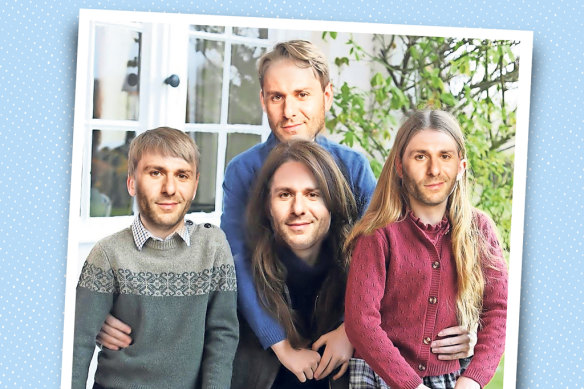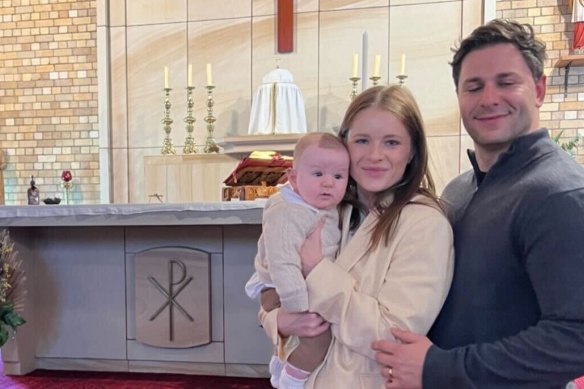This was published 8 months ago
Opinion
Give Kate a break. Family photos are always built on lies
Thomas Mitchell
Culture reporterA few years ago, I moved into my grandparents’ house, and it was exactly how you imagine a grandparents’ house to be: homely, cosy, and purchased in the 1980s for 11 cents and a few gum nuts.
As is so often the case with grandparents’ homes, the walls were covered in an extensive collection of family photos, making it feel less like a house and more like a weird museum dedicated to people I knew intimately.

I, too, have been experimenting with editing.Credit: Michael Howard
I could track my entire life by walking through the house, each room a time capsule from a different year. There I am as an odd-looking baby, on my first day of school, on my last day of high school, graduating from university, and going on holidays.
But sitting on the mantelpiece in the loungeroom, one photo took pride of place: a professionally taken portrait of me, my brother and sister, and our parents. Based on everyone’s hair, the year was 1995, and we looked happy, if not a little cultish.
When the pandemic hit, I spent a lot of time considering this picture because, well, I spent a lot of time sitting in the lounge room.

The most bizarre thing about this photo is that both my brother and I look like Ray Martin from different eras.
The more I looked at it, the more I romanticised the image. It featured my parents (pre-divorce) looking every inch the loved-up couple, their hands around my brother and sister, who pose adorably like two tiny news anchors. Then there’s me, wearing double denim and beaming like a young Ray Martin. A wholesome family, a perfect day!
In a time of great uncertainty, the photo became something to hold on to, a reminder that things were once just fine and would be fine again. Eventually, real life resumed, and I forgot about the photo until one day when my mother pointed at the picture and laughed: “This was the worst day.”
She explained that my brother, sister, and I spent the morning fighting, and none of us were happy with the clothes she’d laid out for us (upon reflection, our anger seems justified).
To make matters worse, my father, who is slightly shorter than my mother, was given a box to stand on to appear taller. You can’t have the head of the family being a head shorter than his wife, right?
“Notice he is taller than me in the photo,” my mother explained. “It’s a nice memory, but it isn’t real.”
This is precisely what the rest of us were thinking this week when we witnessed the most amusing and confusing royal scandal since Fergie had her toes sucked in Saint-Tropez.
Earlier this week, in an effort to counter theories about her whereabouts and well-being, the Princess of Wales posted a seemingly harmless Mother’s Day photo, which soon became A Very Big Deal.
Within 24 hours of the photograph’s release, global picture agencies confirmed it had been digitally manipulated, forcing Kate, rebranding as C, to jump on social media and admit defeat.
“Like many amateur photographers, I occasionally experiment with editing,” wrote C. “I wanted to express my apologies for any confusion about the family photograph we shared yesterday.”
Naturally, the internet melted down, but I couldn’t understand what the big deal was. Aside from the insane crowd who genuinely need proof of life from a person they don’t know, why is anyone shocked that family photos are built on lies?
For as long as we have posed for pictures, we have projected an image of ourselves that is an improved version of the truth. Whether photoshopping Princess Charlotte’s blurry sleeve or standing on a box to seem taller, the desperate pursuit of perfection is not new.
Our self-editing stretches way back to the early days of photography when, according to Angus Trumble, author of A Brief History of the Smile, poor dental health meant people kept their mouths shut and refused to smile. “They had lousy teeth if they had teeth at all, which militated against opening your mouth in social settings,” he told TIME Magazine.
The result? Generations of black-and-white family photos where everyone seems mad.
Now that I have a family of my own, I am totally in favour of airbrushing our special memories. I regularly close my eyes when photos are being taken, as if the very presence of a camera triggers a heaviness in my lids. For the most part, this isn’t an issue, but when we’re at a milestone event, say my child’s christening, it pays to have an app that can open those eyes.

Based on my son’s face, I fear he has inherited my inability to take a nice photo.
The point is that humans are inherently vain creatures. Thanks to technological advancements (shout out to Photoshop and Face Tune), it is little wonder that even a princess spends her evenings removing errant hairs from a photo of her otherwise flawless family.
We all know life is far from picture-perfect, but why should that stop us from having perfect pictures?
Find more of the author’s work here. Email him at thomas.mitchell@smh.com.au or follow him on Instagram at @thomasalexandermitchell and on Twitter @_thmitchell.
Find out the next TV, streaming series and movies to add to your must-sees. Get The Watchlist delivered every Thursday.